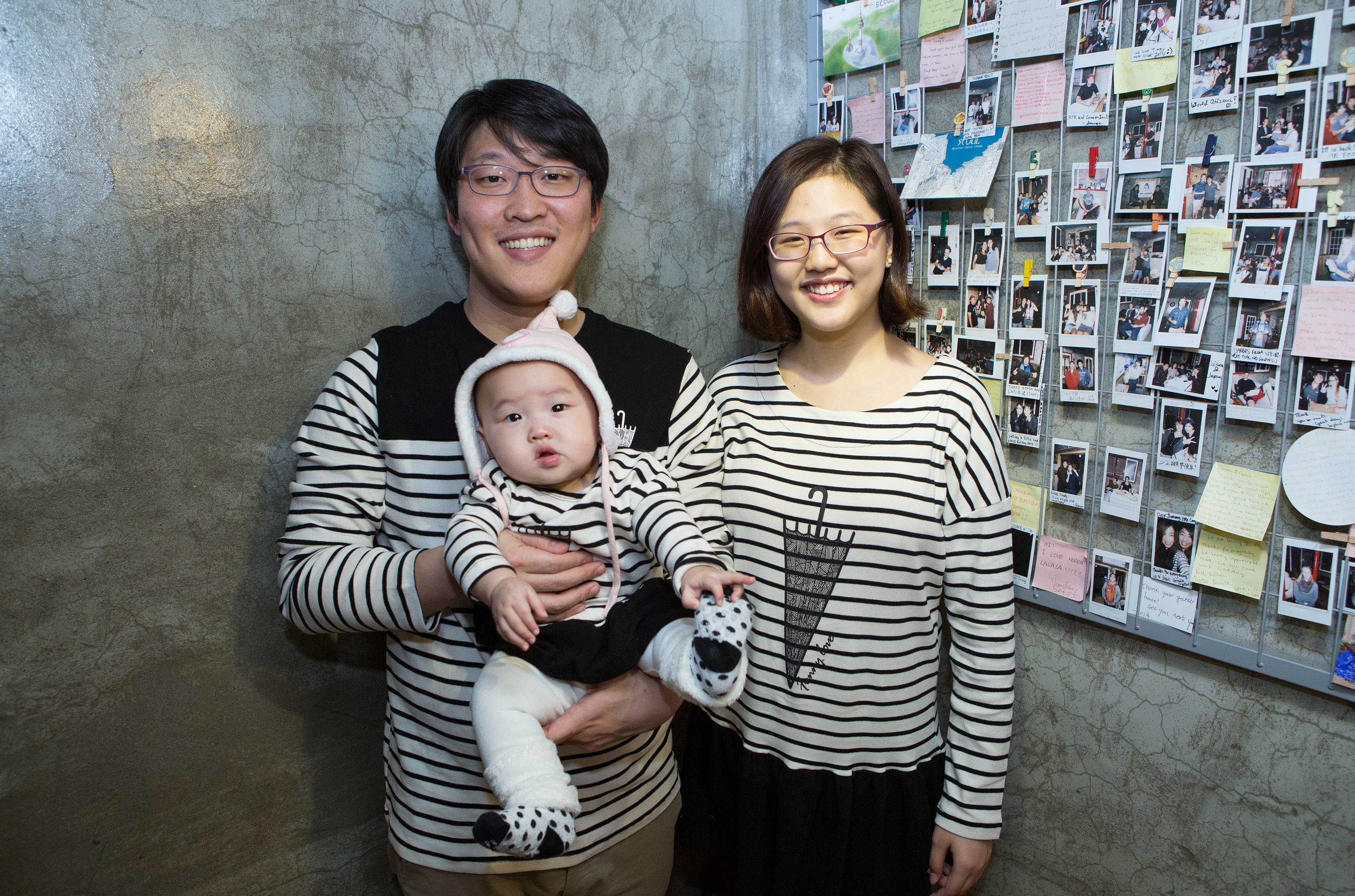SEOUL • When Mr Jimmy Kim met Singaporean Grace Wong in Seoul, they became a couple after just three dates on three consecutive nights.
Taking her home to meet his parents, however, took a longer time to plan as his mum was against his dating foreigners, said the 36-year-old guesthouse owner.
Working at a non-governmental group dealing with migrant workers in South Korea, his mother had seen too many broken interracial families and did not have a good impression of mixed marriages, he added.
But the older woman gave the couple her blessings after getting to know the bubbly Ms Wong, 26, who was preparing to attend university in Seoul when they met in 2012.
"Getting his mum to approve of our relationship was nerve-wracking but I'm glad that in the end, she was able to see me for who I am and not brush me away just because I'm a foreigner," said Ms Wong.

The couple got married early last year and are now proud parents of a seven-month-old daughter.

Interracial marriages like theirs have grown since the 1990s in largely homogenous South Korea as the country started opening up following the end of military rule in 1993, and its people engaged in trade and tourism exchanges with nationals of neighbouring countries, including China, Vietnam and the Philippines.
As of 2014, there were 795,000 multicultural family members, comprising South Koreans, their foreign spouses and their biracial children, living in the nation of 50 million people, according to the Ministry of Gender Equality and Family. The country is also home to about 1.7 million foreigners.
Over 63 per cent of interracial marriages are between South Korean men and foreign-born women, the majority of whom hail from China, Japan and South-east Asian countries such as Vietnam and the Philippines. South Korean women marrying foreign men make up 24 per cent, and the rest are marriages that include one or two naturalised foreigners.
Housewife Nerissa Huerta, 40, gave up her Filipino citizenship to become a South Korean in 2004, five years after she moved to Seoul with her Korean husband, whom she met in church in her hometown, Cebu. The couple have two daughters aged nine and 16, and a son, four.
"My husband is a very kind and loving guy who works very hard for our family. He always hugs and kisses me and tells me 'saranghaeyo' (Korean for I love you)," said Ms Huerta, whose marital bliss inspired her older sister and cousin to also marry Korean men.
By 2020, South Korea's multicultural families are expected to hit one million members - a huge jump from just 330,000 in 2007.
What started in the 1990s as a trend of rural-area bachelors of lower socio-economic status going abroad to look for brides in less-affluent countries like China, Vietnam and Cambodia - a trend also evident in developed economies Japan and Singapore - has evolved into a social phenomenon that requires government action to help migrant wives and their biracial children assimilate into life here and protect them from discrimination and domestic abuse.
Under the Support For Multicultural Families Act, which was enacted in 2007 and made into law in 2010, the South Korean government has set up more than 200 multicultural family support centres to provide marriage counselling as well as language and cooking classes and job training to migrant wives, mainly those from lower-income families.
Over 50 per cent of the migrant wives are from China, half of whom are ethnic Chinese and the other half ethnic Koreans from the Chinese north-east who are viewed as the best match for Koreans as they already speak the same language.
Mail-order brides - women who register with international marriage agencies for marriage with foreigners to escape hardship back home - from Vietnam and Cambodia are also coveted as the women are seen as obedient and subservient to men.
Those who met through marriage brokers accounted for 25 per cent of all interracial marriages in 2012, according to official data. This group is known to face greater marital problems, like domestic violence, communication breakdown and marriage scams.
To clamp down on unscrupulous brokers and migrants looking for sham marriages to gain citizenship, the government has tightened rules for mail-order brides since 2010, like requiring them to pass a Korean language proficiency test before entering South Korea. This has led to a decline in the number of interracial marriages. There were 24,387 such marriages registered in 2014, a 9.5 per cent drop from the year before and the lowest since 2003.
Last November, a revision to the Multicultural Families Act was made to put greater emphasis on changing biased views of these families, preventing discrimination of biracial children and encouraging more openness among Koreans towards these families.
This marks a shift in the government's policy, from merely integrating migrant spouses into the Korean society to more active efforts at promoting multiracial harmony. Details are being worked out and will be announced later.
When implemented, this change will be welcomed by observers who feel that South Koreans are still largely ignorant about foreign cultures, due to a lack of knowledge of and exposure to the outside world.
Ethnic homogeneity is still a source of national pride and South Koreans tend to look down on people from countries that are less developed than their own.
Sales representative Donnabelle Casipong, 44, moved from the Philippines to Seoul after marrying a South Korean man in 1999. They have two sons, aged 13 and 15. She recalled how her older son was labelled an African by his Primary 1 classmates after they saw her with him and noticed her darker skin tone.
She also said her husband did not allow her to hold cash - a common practice in mixed marriages to prevent the foreign wife from running away with the money. Feeling frustrated, she said she started working in various jobs, such as as an interpreter , and is now financially independent.
To help others like Ms Casipong find jobs, the Seoul Metropolitan Government (SMG) organises job fairs for them and provides coaching for interviews and job training. The latest figures show that about 36 per cent of migrant wives are unemployed, mainly due to a lack of experience and the language barrier.
There are about 74,000 multicultural households living in Seoul alone, according to SMG. Chinese migrant spouses make up 76 per cent of the group, followed by Vietnamese (7 per cent), Japanese (4 per cent) and Filipinos (2.3 per cent).
SMG also runs a tutoring programme for biracial children in primary school whose parents cannot afford to send them for tuition classes, and a crisis hotline in six languages, including Mandarin and Vietnamese.
Mr Paul Carver, the head of Seoul Global Centre, which is run by SMG and caters to foreigners, said it also set up mobile counselling booths in migrant neighbourhoods to provide legal advice and marriage counselling to those in need. The crisis hotline dealt with 19,000 cases last year and the main complaints were divorce, legal problems and life difficulties, he added.
There are also ground-up efforts, like the Modoo multicultural library in Dongdaemun, which is run by civic group Purun People. Purun activist Jang Ji Hyun said the library was started in 2008 to create a space for migrant mums to gather and find books in their mother tongue to read to their young children.
The library, which stocks 9,000 books from 22 countries, also organises three Korean language classes a week for about 20 of these mums.
However, finding acceptance is not as simple as speaking the same language. A 2014 study by the Asan Institute of Policy Studies showed that nearly 60 per cent of respondents viewed immigrants from China and Japan negatively.
Dr Kim Ji Yoon, who oversaw the survey, said the largely homogenous country is still "not that accepting" when it comes to multicultural families and migrant workers, and "a lot of Korean people think that migrants don't work hard enough to adjust to Korean society".
Migrant wives who were thrown into the deep end when they first moved to South Korea would beg to differ.
Many had to grapple with learning a new language while trying to cook Korean meals and adjust to a culture that places great emphasis on respect for elders.
Some marriages end up breaking down, especially in cases of domestic violence. Official data shows that there were 12,902 divorces in 2014 between interracial couples, which accounted for 11.7 per cent of all divorces in the country.
Ms Annette Prudente, 37, who hails from the Philippines, suffered an abusive relationship with her South Korean husband. They divorced in 2010. "When he hit me, I went to the police for help but they told me to go back to him. I ran away three times but went back for my son. He hit me again, and I filed for divorce."
She is now working in an electronics firm to support her son, 11. She cannot return to the Philippines as she had renounced her citizenship in 2007 to become a South Korean citizen.
If left unaddressed, multicultural families and migrant workers could become a divisive social issue in the future, said Dr Kim. She also stressed the need for public education to change attitudes towards migrants before xenophobia raises its ugly head. "The South Korean government has no clear direction yet. Its multicultural policy is more of a coexisting race policy," she said.
Ms Casipong added: "We need to educate Korean people that their country is no longer homogenous. They must open their minds to the fact thatit is different now."



